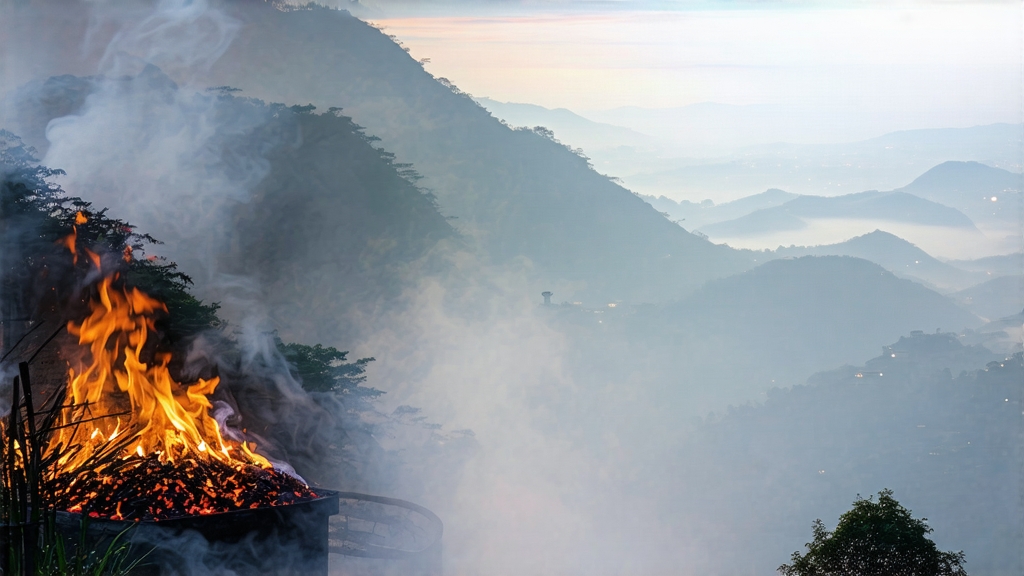
If you trace the family tree of every bold, malty black tea on earth, you will arrive at one mist-shrouded cliff in China’s Wuyi Mountains where, sometime around 1568, a passing army forced tea farmers to improvise. To dry their half-oxidized leaves before the soldiers arrived, the farmers spread them over smouldering pine boughs. The accidental smoke infusion created a tea so alluring that Dutch traders carried it across oceans, coining the name “bohea” and igniting Europe’s centuries-long black-tea romance. That tea is Lapsang Souchong—today celebrated as the progenitor of all black teas and still produced by fewer than 300 families in a 600-square-kilometer national reserve.
Geography and Cultivars
The authentic appellation is Tongmu Guan, a tiny village tucked into a granite gorge at 27° N latitude. Here, subtropical mists rise from the Jiuqu (“Nine Bends”) Stream, diffusing sunlight and coaxing slow, amino-rich growth in two indigenous cultivars: Xiao Zhong (small leaf) and Cai Cha (mixed color). Spring buds are plucked with one leaf, never later than Grain Rain, when the catechins are gentle enough to balance the forthcoming smoke.
Withering: Bamboo Mats under the Stars
Farmers lay the leaves on large-mesh bamboo trays set on wooden racks inside open-walled sheds. From 7 p.m. to 5 a.m. they turn the leaves every 30 minutes, allowing mountain breezes to carry away 65 % of moisture. The cool night wither preserves floral precursors that later contrast the smoky finish.
Oxidation: The 28 °C Room
At dawn the softened leaves are rolled for 45 minutes in a cast-iron cylinder rotating at 28 rpm, rupturing cells and exposing enzymes to oxygen. They are then heaped in pine-wood crates lined with wet cloth; the temperature is held at 28 °C for 2.5 hours, during which the leaf color shifts from jade to copper to dark mahogany. Master sniffers plunge bare forearms into the pile every 20 minutes, judging readiness by the scent of over-ripe peach and toasted walnut.
Pan-Firing: Killing Green with Heat
A 220 °C wok arrests oxidation in 3 minutes. The leaves are tossed by hand using wicker gloves; the motion is a figure-eight that mimics the flow of the nearby stream. This step sets the sugars, ensuring the later smoke will cling rather than overpower.
Smoke-Drying: The Pinewood Long Kiln
Here lies the signature. Fresh Masson pine and local Chinese red pine are split into 40 cm logs, stacked into a half-subterranean furnace, and lit so the wood smoulders rather than flames. A brick flue carries the cool, aromatic smoke into a second chamber where the tea rests on multi-tiered bamboo sieves. For eight hours the leaves absorb phenols, guaiacol and syringol—compounds that impart notes of smoked apricot, resin and a whisper of salami. The final moisture is 4 %, low enough for decades of aging.
Grading and Styles
Traditional Lapsang Souchong is divided into three grades. Superior (tippy) uses only buds, yielding a creamy, incense-like cup. Classic grade balances leaf and tip, giving the familiar pine-smoke and longan sweetness. Finally, “unsmoked” or Zheng Shan Xiao Zhong is processed the same way but dried over charcoal instead of pine; it preserves the honeyed minerality without the campfire aroma, offering a gateway for novices.
Chemical Signature
Gas-chromatography reveals 3-methyl-1,2-cyclopentanedione at 2.3 ppm—ten times higher than in any other black tea—explaining the lingering sweet coolness on the palate. L-theanine remains at 1.8 %, unusually high for a black tea, thanks to the gentle night wither; this cushions the smoke with a velvety umami.
Water and Leaf Ratio
Use 4 g of leaf for 120 ml water. If only a western mug is available, halve the leaf but prolong the infusion to 4 minutes; the large smoke molecules dissolve slowly.
Temperature
95 °C is optimal. Boiling water can scorch the resinous oils, turning the liquor bitter like creosote.
Gongfu Ceremony
- Rinse the gaiwan with hot water; discard.